A model of degassing for Stromboli volcano
Summary (4 min read)
1. Introduction
- This, combined with recent developments in H2O–CO2 micro-analysis in silicate materials and the refinement of thermodynamic saturation codes, now opens the way to more detailed inspection of degassing processes.
- Here, the authors report on the first MultiGAS measurements including H2O of the volcanic gas plume of Stromboli, an active basaltic volcano in Southern Italy (Fig. 1).
- This combined volcanic gas-melt inclusion-thermodynamic approach finally leads to thorough characterization of degassing processes at Stromboli volcano, with general implications for all basaltic volcanism.
2. Stromboli volcano
- The persistent Strombolian activity, for which the volcano is famous, began after the 3rd–7th centuries AD, and since then has continued without significant breaks or variations (Rosi et al., 2000).
- Explosive activity is associated with a continuous “passive” streaming of gas from the crater area and with active degassing (“puffing”) originating from discrete small gas bursts, every 1–2 s. During the lava effusion, a paroxysmal eruption also occurred (on 15 March), which erupted a significant amount of basaltic pumice (Landi et al., 2009).
- During July–December 2008 (the period over which the volcanic gas measurements are reported here), the volcano showed its typical activity, with rhythmic Strombolian explosions of variable energy at an average frequency of 10–15 events/h (see open-file reports at www.ct.ingv.it).
- On September 7, December 6 and 17, three slightly more energetic events occurred.
3. Technique
- The volcanic gas measurements reported here were carried out from July to December 2008, using the permanent MultiGAS installed on the summit of Stromboli by Istituto Nazionale di Geofisica and Vulcanologia (Sezione di Palermo).
- Signals from both sensors were captured every 9 s from a data-logger board, which also enabled data logging and storage.
- Because the instrument is located ∼150 m S–SE of the crater terrace (Fig. 1), plume gas sensing was only possible when moderate to strong winds from the northern quadrants blew on the island.
- In contrast when the plume was gently lofting, rising vertically, or being dispersed north, the MultiGAS consistently detected the typical H2O (13,000– 18,000 ppm), CO2 (∼380 ppm), and SO2 (b0.1 ppm) concentrations in background air, and the cycle was considered null (e.g., no ratio was calculated from the data).
4.1. Raw data and calculation of volcanic gas composition
- Fig. 2 shows an example of 1-cycle acquisition from the permanent MultiGAS at Stromboli.
- From the raw plume concentration data (in ppm), the volcanic gas plume H2O/SO2 and H2O/CO2 ratios were derived by calculating the gradients of the best-fit regression lines in H2O vs. SO2 and H2O vs. CO2 scatter plots (Fig. 3), as previously reported for Etna (Shinohara et al., 2008).
- This assumes that contributions from undetected species (e.g., H2, H2S, HCl) are relatively minor.
- Visual observations and cross correlations of their dataset with seismic and thermal signals (available at http://www.ct.ingv.it) indicated that such short-term variations (generally lasting less than 2 min) systematically occurred soon after individual Strombolian bursts.
- When the wind was particularly strong and explosive activity high, this syn-explosive gas phase, known to be compositionally distinct from the quiescent plume (Burton et al., 2007b), eventually reached the instrument (a few seconds after the explosion) before being diluted (and homogenised) within the bulk plume.
4.2. The H2O–CO2–SO2 composition of Stromboli's plume
- As such, they resemble quite closely the typical composition of volcanic gases from arc-settings, though sharing with nearby Etna (Shinohara et al., 2008) a characteristic of CO2-enrichment (most volcanic gases from arc basaltic volcanoes have N90% H2O; Shinohara, 2008).
- The most striking feature of the dataset is the large spread of plume compositions observed in only 6 months of observations.
5. Discussion
- The striking range of volcanic gas compositions at Stromboli suggest dynamic magma degassing processes at this open-vent volcano.
- This deep source area also supported the idea of a separate ascent of gas and melt in the shallow (less than 2.7 km) plumbing system, as also proposed for other basaltic systems (Edmonds and Gerlach, 2007).
- The authors measurements here extend further the conclusions of Burton et al. (2007b): the temporal variability of the composition of the bulk plume requires the existence of a complex degassing regime in which a separate gas ascent plays a key role (Pichavant et al., 2009).
- Visual observations suggest that the bulk Stromboli's plume is essentially contributed by both quiescent gas release from the magma ponding at the crater terrace' open vents, and by small bursts of over-pressurised gas pockets at the magma-free atmosphere (Harris and Ripepe, 2007).
- Finally, comparison between modelled and observed volcanic gas compositions (Section 5.3) offers new clues on volcanic degassing processes, and on the structure of the magmatic plumbing system of Stromboli.
5.1. Melt inclusion record of magma ascent and degassing
- There is consensus (Bertagnini et al., 2008) that two magma types are involved in the present-day Stromboli's activity.
- The persistent behaviour of the volcano implies that a supply of deeply derived magmas must occur not only prior to/during a paroxysm, but also during the normal Strombolian activity (yet at a slower rate).
- This has three main implications and consequences: (i) first, de-hydration of a magma can be caused by fluxing with deep-rising CO2-rich gas (Spilliaert et al., 2006), a fact which is suggestive of the presence of a magma ponding zone at 2–4 km bsv, where CO2-rich gas bubbles accumulate to contents N5 wt. % (Métrich et al., 2010).
- The contrasting compositions, volatile contents, and depth of storage of LP and HP magmas (Table 2) imply that the magmatic gas phases in equilibrium with (and separated from) these two magma types are inevitably different, as calculated below.
5.2. Numerical modelling
- Volatile contents in MIs (Table 2) are used here to initialize model calculations of volatile partitioning between the magmatic gas phase and the melt, which the authors performed using the code described in Moretti and Papale (2004).
- The authors utilised the code to perform two sets of complementary calculations.
- LP runs were initialised with the input parameters summarised in Table 2.
- Themodel results are critically dependent on the choice of the total (exsolved+dissolved) magma CO2 content: four sets of LP runs were thus carried out at different CO2 contents (0.2, 2, 5 or 20%, respectively), to account for the presence of a non-negligible (but poorly constrained) fraction of CO2-rich gas bubbles at reservoir conditions.
- The highest entrapment pressure (∼100 MPa) derived from volatile contents in MIs (Table 2) was taken as the starting pressure of their simulations, followed by step-wise pressure decrease in first closed-system to then opensystem conditions.
5.2.1. Model results, and comparison with natural data
- The outputs of model calculations are, for each run and at each pressure, the equilibrium volatile compositions of coexisting melt and vapour phases.
- The authors model results are qualitatively similar to the pressure-related model degassing trends presented by Allard (2010) (see his Fig. 3), which were yet based on the use of different saturation model and assumptions.
- As such, the volatile compositions of glass embayments may reflect gas-melt interactions within the CO2-rich intermediate (2–4 km deep) magma ponding zone (cfr. 5.1).
- Modelled dissolved sulphur contents (Fig. 7b) are also consistent with MI record, and again support a mechanism of progressive increase of the CO2TOT/H2OTOT ratio from trends 1 to 4.
- The authors note however that some of the richest CO2 volcanic gas data are consistent with model gas compositions calculated at P=100–120 MPa in the LP model run 1 (CO2TOT=0.2 wt.%; Fig. 8).
5.3. A model of degassing for Stromboli volcano
- The authors model calculations above provide a quantitative background for interpreting the source processes controlling the time-changing composition of Stromboli's volcanic gases.
- In the most extreme conditions, the CO2-rich gas bubbles may be thought to be sourced by the deep (7–11 km deep) LP magma storage zone; though partial gas-melt reequilibration at shallower depths (and particularly upon gas bubble accumulation within — before leakage from — the intermediate 2– 4 km deep magma ponding zone) cannot be ruled out.
- Secondly, there is supporting evidence at Stromboli for that continuous magma convection takes place within the shallow (b1 km) dyke system (Harris and Stevenson, 1997).
- The shallow convective overturning of the HPmagma obviously gives rise to a second source of volatiles: degassing of dissolved volatiles in the ascending HP magma will produce gas bubbles which pressure-dependent compositional evolution is best described by curves 5 and 6 in Fig.
6. Conclusions
- The MultiGAS volcanic gas observations presented here show that, in spite of the relatively uniform activity and petrology of erupted solid materials, Stromboli shares with other basaltic volcanoes an exceptional variability in gas compositions.
- The mechanisms controlling such time-changing nature of Stromboli's gas emissions have been explored by combining gas measurements with the MI record of volatile abundance in magmas, and by contrasting natural compositions with model results derived with an equilibrium saturation code.
- From this, the authors propose that the compositional features of Stromboli's quiescent and syn-explosive gas emissions result from themixing of gases persistently sourced by (i) degassing of dissolved volatiles in the porphyric magma filling the upper (b1 km) dyke-conduit system; and (ii) CO2-rich gas bubbles, originated at depth (at depths N4 km, or PN100 MPa) in the plumbing system.
- The proposed mixing mechanism is constrained by independent petrologic and model data, and it is geologically straightforward since it only requires a persistent but time-modulated source of deep gas bubbles; this however does not exclude that additional control mechanisms on volcanic gas composition might be at work.
- The authors conclude however that, since magma fluxing by a free CO2-rich vapour phase is a recurrent process, the proposed degassing mechanism is probably a key to interpret volcanic gas observations at many basaltic volcanoes.
Did you find this useful? Give us your feedback
Figures (10)

Fig. 6. Schematic cross-section showing the main features of Stromboli's crustal plumbing system (modified from Métrich et al., 2010). See text for discussion. 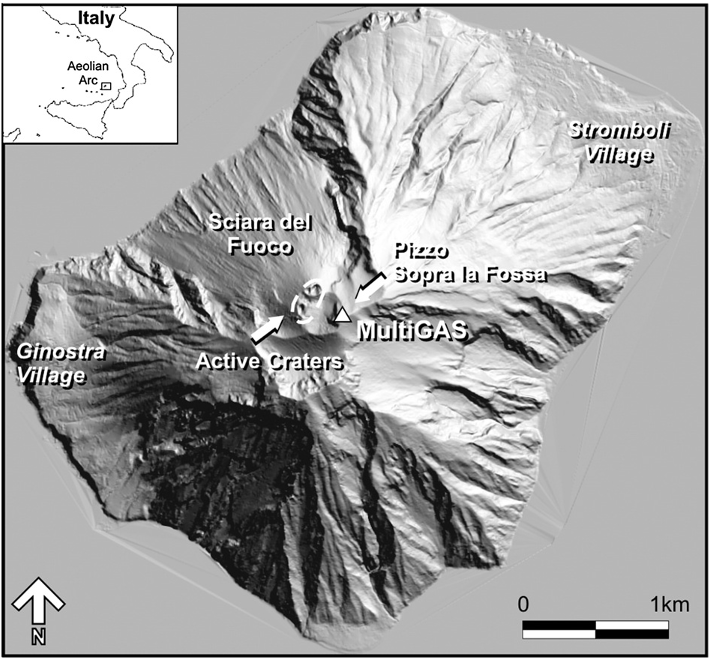
Fig. 1. A map of Stromboli showing the location of the permanent MultiGAS on Pizzo Sopra la Fossa. 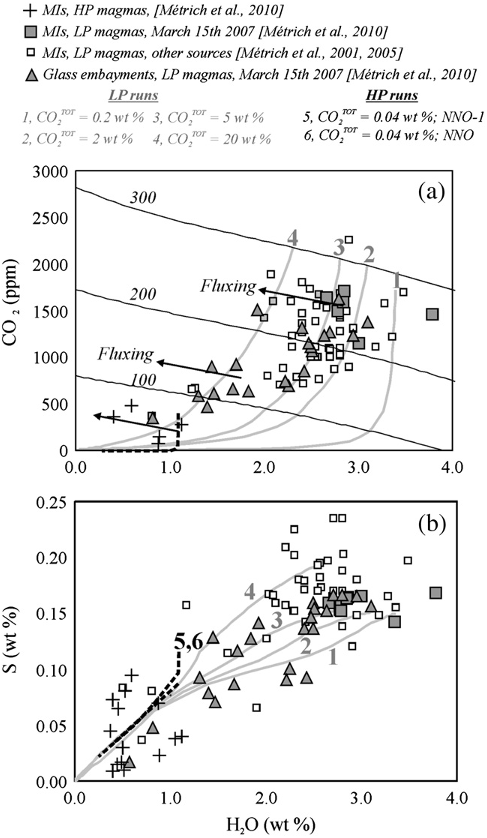
Fig. 7. Volatile abundances in Stromboli's melt inclusions and glass embayments contrasted against results of the saturation model. Data fromMétrich et al. (2001, 2005, 2009) and Bertagnini et al. (2003). (a) H2O vs. CO2; (b) H2O vs. S. The grey solid lines are model results from LP runs 1–4, whilst black dashed lines show model results from HP runs 5–6. Comparison of natural and modelled compositions confirms that the deep (PN100 MPa) LP magma contains a high (2–5 wt.%; model curves 2–3) fraction of gas bubbles at reservoir conditions. Glass embayment formed at P∼100 MPa are H2Opoorer than predicted by model curves 2–3, suggesting some extent of gas fluxing with CO2-rich gas bubbles. This triggers de-hydratation of the LP magma, and probably controls transition to HP magma. The same process likely occurs also in the upper conduit system (compare model trends 5–6 with volatile abundances in HP magmas). In a, isobars are traced under a fixed Fe2/Fetot ratio of 0.24 (Table 2), and are thus slightly different than those originally reported byMétrich et al. (2010) (who, yet using the same saturation model, used a constant ΔNNO value, thus yielding variable Fe2/Fe3 proportions depending on melt composition, and water particularly). 
Table 1 Compositions of Stromboli's volcanic gas plume (in mol%). We derive compositions for both the bulk plume (essentially contributed by persistent passive degassing) and the syn-explosive plume (the gas jet of a Strombolian explosion, reaching the MultiGAS a few seconds after the burst, and before being diluted in the main plume). 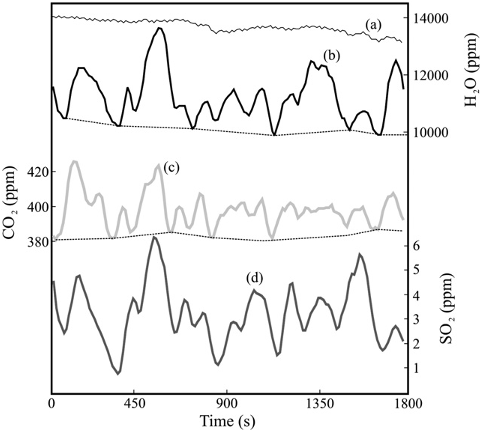
Fig. 2. An example of a 1800 sMultiGAS acquisition at Stromboli (acquisition frequency, 9 s). Whilst small erratic variations of H2O concentrations are typically measured when the plume is condensing (curve a), more systematic variations (curve b) are observed in dry weather conditions and when the plume fumigates the Pizzo Sopra la Fossa area. These are correlated with variations of CO2 (curve c) and SO2 (curve d) concentrations. In such circumstances, volcanic H2O was derived from the raw data (b) by subtracting background air H2O content; this required fitting a polynomial function (shown as a dotted line) to H2O measurements for which a SO2 content of nearly 0 was consistently detected. 
Table 2 List of input parameters of model runs. LP runs simulate isothermal closed system ascent of LP magmas (melt composition data Métrich et al., 2010) within their storage zone (300– 190 MPa pressure range), and upon shallow emplacement (down to 100 MPa). Redox conditions along the decompression path were fixed by the Fe2+/Fe3+ buffer, for which we adopted the value of 3.4. This choice is based on XANES determinations on a hydrous (H2O=2.9 wt.%) LP magma melt inclusion (Bonnin-Mosbah et al., 2001), but is also consistent with the olivine-liquid iron and magnesium partition observed in a large set of Stromboli MIs (Bertagnini et al., 2003). The resulting logfO2 conditions range from 0.07 to 0.82 NNO (NNO is the Nickel–Nickel Oxide buffer). Note that while MI compositions can be taken as good proxies for total (exsolved+dissolved) water and sulphur contents (then evaluated as H2OTOT: 3.4 wt.%; STOT: 0.16 wt.%, respectively), LP magmas were probably already saturated with a CO2-rich gas phase when the most primitive MIs formed. If such, the highest measured dissolved CO2 content (∼0.2 wt.%; see Fig. 7a) in MIs would significantly underestimate CO2TOT. Four separate LP runs (with different CO2TOT contents; these should be viewed as CO2 concentrations in the magma, i.e., in the melt plus gas suspension) were thus carried out. As for HP runs, we considered a shoshonitic melt with total CO2, H2O, and S contents of 0.04, 1.2 and 0.1 wt.%, respectively (as from representative compositions of MIs in olivines from erupted HP products; Métrich et al., 2010). The recurrent observation of a sulphide immiscible liquid phase in MIs suggests that the HP magma is potentially in a more reducing redox state than the LP magma; we therefore performed model runs at both NNO at NNO-1 redox conditions. For both LP and HP runs, melt composition data are from Métrich et al. (2010). 
Fig. 4. High-resolution (9 s) record of (a) plume ratios and (b) CO2 concentrations, showing the contrasting compositions of the passive and syn-explosive gas plume emissions. In the most favourable conditions (strong winds blowing from the N), a Strombolian explosion (grey arrow labelled “EXP”) is followed (with a time-lag of a few seconds) by a brief (lasting a few minutes) but significant increase of CO2 concentrations and CO2/SO2 ratios detected by the MultiGAS. The syn-explosive gas phase is typically H2O-poorer (and CO2-richer) than the passive plume released in between explosions (this contribution by far dominating Stromboli's bulk plume emissions in the long-term). 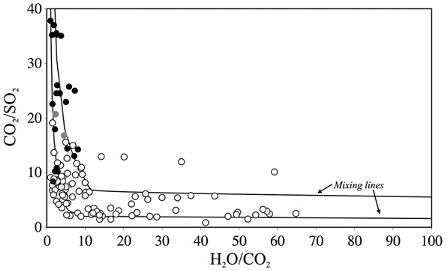
Fig. 5. In a H2O/CO2 vs. CO2/SO2 scatter plot, Stromboli's plume gas emissions are shown to range from CO2-rich to H2O-rich. The syn-explosive (black circles) and quiescent (open circles) plumes have distinct compositions, with some overlap. Grey circles are FTIR-sensed gas compositions for Strombolian explosions (Burton et al., 2007b). Curves labelled “Mixing lines” are calculated as described in the caption of Fig. 8, and in Section 5.2. 
Fig. 3. Scatter diagram of H2O vs. SO2 and H2O vs. CO2 concentrations acquired during 1 measurement cycle. The H2O/SO2 and H2O/CO2 plume ratios are calculated from the gradient of the best-fit regression lines. 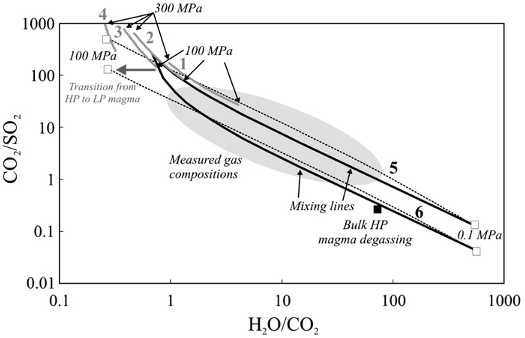
Fig. 8. Gas-phase model results summarised in a H2O/CO2 vs. CO2/SO2 scatter plot. The grey solid lines show modelled gas compositions in LP runs 1–4 over the 300–100 MPa pressure range. Black dashed lines illustrate model results of the evolution of the magmatic gas phase formed by decompression (100–0.1 MPa pressure range) of the HP magma (HP runs 5–6). The curves labelled “Mixing lines” simulate mixing of CO2-rich gas bubbles in equilibriumwith the LPmagma at 210 MPa (LP run 2) with the gas phase produced by degassing of dissolved volatiles in the HP magma at 0.1 MPa (runs 5–6). The dashed area marks the field of measured gas compositions. The black square symbol labelled “bulk HP magma degassing” represents the hypothetical composition of the gas phase produced via closed system (bulk) degassing of the HP magma upon decompression from 100 to 0.1 MPa. Clearly, this is CO2-poorer than our observed gas compositions. A zoom on the comparison between measured and modelled gas compositions is given in Fig. 5.
Citations
309 citations
Cites background from "A model of degassing for Stromboli ..."
...Gas can stream through magma from depth to the surface (Wallace et al. 2005), as surmised to occur at Soufrière Hills volcano, Montserrat (Edmonds et al. 2010) and Stromboli volcano (Aiuppa et al. 2010)....
[...]
172 citations
Cites background from "A model of degassing for Stromboli ..."
...An important development is that long-term installations (using Wi-Fi or cell-phone networks, or satellite telemetry) are beginning to provide valuable and near-real time insights into the relationships between surface emissions and magmatic processes (e.g., Aiuppa et al. 2007b, 2010)....
[...]
...2003, 2008), and volcanic gas emission data (Allard et al. 1994 ; Burton et al. 2007a ; Aiuppa et al. 2010; Allard 2010)....
[...]
...…whose plumbing system is constrained by both phase equilibria (Di Carlo et al. 2006; Pichavant et al. 2009), detailed melt inclusion work (Métrich et al. 2001; Bertagnini et al. 2003, 2008), and volcanic gas emission data (Allard et al. 1994; Burton et al. 2007a; Aiuppa et al. 2010; Allard 2010)....
[...]
148 citations
Cites background or methods or result from "A model of degassing for Stromboli ..."
...…from https://academic.oup.com/petrology/article-abstract/52/9/1737/1437269/Experimental-Simulation-of-Closed-System-Degassing by guest on 16 September 2017 from the two volcanoes: Stromboli data are from Bertagnini et al. (2003) and Me¤ trich et al. (2010); Masaya data from Sadofsky et al. (2008)....
[...]
...At Stromboli, petrological studies show that a basaltic magma in equilibrium with a fluid phase in a deep-seated reservoir at 400MPa (Me¤ trich et al., 2001; Bertagnini et al., 2003; Pichavant et al., 2009) starts to degas during ascent. Under these conditions, according to our experimental results, fluids evolve from dominantly CO2-rich at 400MPa, to progressively more H2O-rich until 150MPa, and then become dramatically H2O-enriched at lower pressures. These results are consistent with experimental results obtained for golden pumices from Stromboli (Landi et al., 2004) equilibrated with an H2O^CO2 fluid phase (Pichavant et al., 2009). Burton et al. (2007a) and Aiuppa et al....
[...]
...1 experimental data for S and Cl with the melt inclusions from Stromboli (Me¤ trich et al., 2001, 2010; Bertagnini et al., 2003)....
[...]
...(2003) and Me¤ trich et al. (2010); Masaya data from Sadofsky et al. (2008). As no CO2 data for Masaya were presented by Sadofsky et al. (2008), we used the highest values ( 7000 ppm) reported by Atlas & Dixon (2006). For each volcano two mixtures were prepared with different initial sulphur contents to better investigate the behaviour of sulphur and its potential influence on the behaviour of other volatiles....
[...]
...1 experimental data for S and Cl with the melt inclusions from Stromboli (Me¤ trich et al., 2001, 2010; Bertagnini et al., 2003). In Fig. 12a and b, respectively, we plot S and Cl in melt inclusions against the calculated H2O^CO2 saturation pressure for the same melt inclusion using VolatileCalc [it would make relatively little difference if we calculated pressure from our experimental data or used Papale et al. (2006)]. Melt inclusions show a good match to the low-sulphur series of experiments (St8.1.A), showing little change in dissolved S and Cl from 400 to 200MPa, followed by a sharp decrease in S, but not Cl, at P5150MPa. The matrix glass analyses of Me¤ trich et al. (2001) plot at the low-pressure extremity of this trend....
[...]
126 citations
Additional excerpts
...The first scenario is reminiscent of trends observed at open-conduit volcanoes such as Stromboli and Etna ( [Aiuppa et al., 2007], [Aiuppa et al., 2010] and [Shinohara et al., 2008]); in the Erebus case, the explosive gas composition can be manufactured with ~ 50 wt.% of the deep, almost CO2-pure,…...
[...]
...…P. Papale, H. Shinohara, M. Valenza Forecasting Etna eruptions by real-time observation of volcanic gas composition Geology, 35 (2007), pp. 1115–1118 Aiuppa et al., 2010 A. Aiuppa, A. Bertagnini, N. Métrich, R. Moretti, A. Di Muro, M. Liuzzo, G. Tamburello A degassing model for Stromboli volcano…...
[...]
113 citations
References
124 citations
"A model of degassing for Stromboli ..." refers background in this paper
...The apparent H2O-depletion captured by MIs (relative to model curves) is an hint for that magma fluxing by CO2-rich gas bubbles (leading to magma de-hydration) has a major impact on magma resident in the upper conduit, as observed elsewhere (Collins et al., 2009)....
[...]
113 citations
"A model of degassing for Stromboli ..." refers background in this paper
...Secondly, there is supporting evidence at Stromboli for that continuous magma convection takes place within the shallow (b1 km) dyke system (Harris and Stevenson, 1997)....
[...]
111 citations
"A model of degassing for Stromboli ..." refers background in this paper
...deep) of such gas separation are still not entirely understood (Edmonds, 2008)....
[...]
...…exerts a key control on both quiescent (Burton et al., 2007a) and eruptive (Edmonds and Gerlach, 2007) degassing of basaltic volcanoes, the mechanisms (structural vs. fluid-dynamic control) and depths (shallow vs. deep) of such gas separation are still not entirely understood (Edmonds, 2008)....
[...]
109 citations
108 citations
"A model of degassing for Stromboli ..." refers background in this paper
...…some persistently degassing volcanoes display an apparent stability in both activity state and volcanic gas composition for years (e.g., Nyiragongo, Sawyer et al., 2008), Stromboli shares with nearby Etna (Aiuppa et al., 2007) a timechanging nature of both volcanic activity state and volcanic gas…...
[...]
...Indeed, whilst some persistently degassing volcanoes display an apparent stability in both activity state and volcanic gas composition for years (e.g., Nyiragongo, Sawyer et al., 2008), Stromboli shares with nearby Etna (Aiuppa et al., 2007) a timechanging nature of both volcanic activity state and volcanic gas composition....
[...]